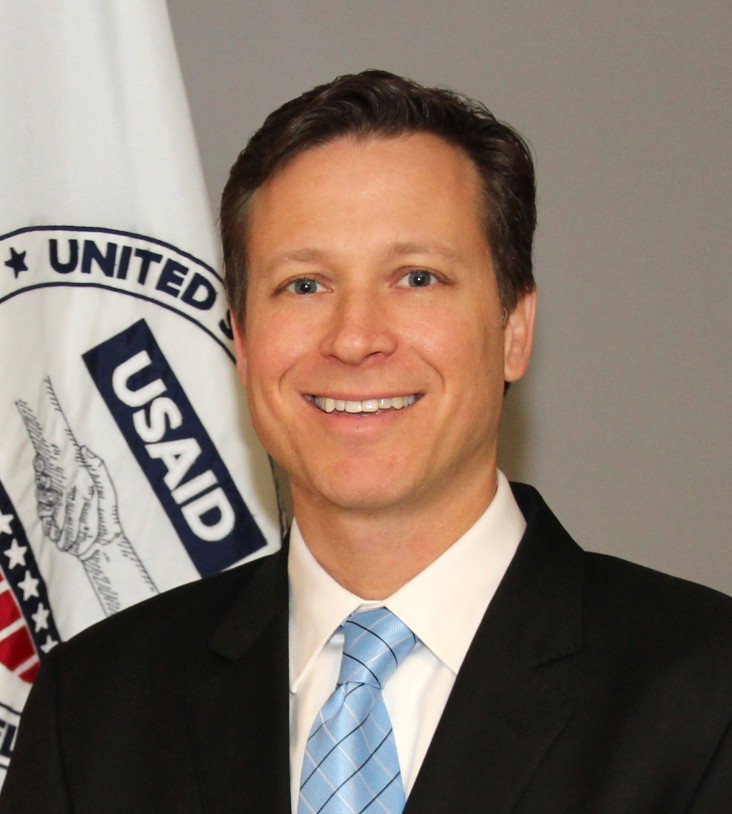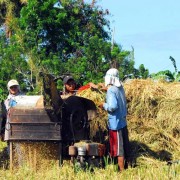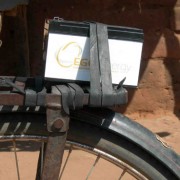FrontLines: What is your role as coordinator for the U.S. Power Africa Presidential Initiative?
Herscowitz: Power Africa is one of the president’s highest priorities for Africa for his second term, and there are 12 U.S. Government agencies that are bringing different tools to help achieve Power Africa’s goal of significantly increasing the number of people in sub-Saharan Africa with access to electricity. To make that happen we’ve selected six focus countries, which are Kenya, Tanzania, Ethiopia, Ghana, Liberia and Nigeria. My job is to bring all those agencies and country teams together to make sure that our activities and our resources are well-aligned, and that everybody is working towards the same goals.
FL: What are the energy challenges that gave rise to the Power Africa initiative?
Herscowitz: Power Africa grew out of a trip to a number of countries in sub-Saharan Africa by officials of several different U.S. Government agencies where they looked for key constraints to economic growth. And it was energy. Countries have to burn expensive, dirty, diesel generators in order for manufacturing to keep up with growth and demand. This is an area where we can have a significant impact to help a country stay on the development path while working with them to find sustainable, cleaner alternatives that will better represent what the African continent should look like from a green perspective over the next century.
There’s significant lack of access to electricity in Africa. In modernizing and rapidly growing countries like Kenya, only 15 percent of the people are connected to the grid, and in rural areas it’s much less. So part of what we’re doing is building the generating capacity to keep up the economic growth and to increase access for the well-being of the general population.
FL: What are the goals and timeline for Power Africa?
Herscowitz: By 2020 we’re looking at bringing online, through direct Power Africa advisory, technical and financing assistance, access for 20 million people or businesses and 10,000 megawatts of new power in the six focus countries. Power Africa uses a unique model for development assistance. We’ve identified large energy transactions that are already in the works between governments and private enterprises and which we can help facilitate. There’s geothermal, gas, solar, wind, hydro and biomass.
We’re looking to see what we can pull out of the U.S. Government’s toolbox amongst the 12 different agencies to either expedite those transactions in some way or remove obstacles that would otherwise prevent them from coming online. Power Africa is putting transaction advisers on the ground and propelling necessary reforms in these countries so that once the first project comes online due to our interventions, the next one will come online without us. Also, trade in the energy sector will increase and could create jobs in the U.S. as well as the focus countries.
Power Africa is not only working on large transactions, but also developing a very robust off-grid and mini-grid strategy, recognizing that there are rural, sparsely populated areas that may not have access to a grid for decades to come. Technologies have come a long way over the past few years -the cost of solar has declined by over 500 percent in the last four years alone. Power Africa is really looking at some community-level solutions for creating mini-grids so that people who are not connected to the grid will still be able to access electricity and get on a path to sustainable development.
That’s how ultimately we’re going to achieve President Obama’s goal of doubling access to electricity in all of sub-Saharan Africa, because the private sector will see that there is the proper environment to invest their funds and they’re going to want to invest in sub-Saharan Africa.
FL: Is there a link between obtaining energy security and ending extreme poverty?
Herscowitz: Absolutely. Electricity has to be a basic part of everyone’s modern day life. Not everybody needs an air conditioning unit, but everybody does need to have some level of electric power in order to communicate and produce and thrive as a human being. As the world continues to globalize, when a person doesn’t have access to even just a telephone, it puts them at a significant disadvantage. Electricity is key to almost every aspect of one’s life, whether it’s having a light bulb in your house so that you can study at night, or it’s being able to run a piece of machinery to help you farm, or keep your shop open past dark. If you have electricity to charge a cell phone you can be in constant communication for your small business; a health center can refrigerate life-saving vaccines or a hospital can run life-saving equipment.
In many of these countries, the poor cook their food by burning wood, so not only is that a health issue but it’s also an environmental issue. As they transition to cleaner energy sources, it’s going to improve the health indicators in those communities and within the households, it’s going to free up productive time used to collect wood or make charcoal, and it’s also going to help avoid deforestation.
So a predictable supply of electricity is something that everybody really needs and wants. It’s not necessary always to have electricity 24 hours a day, but if someone knows what two hours a day they would have electric power, they’d be able to plan their daily activities and improve their lives. Having access to safe, affordable electricity has a direct link to ending poverty, because it’s the lack of electricity that prevents manufacturers or farmers from producing at the levels that they need to create jobs.
FL: On the commercial and regional side, what are the implications of Power Africa for trade or cross-border commerce and regional development?
Herscowitz: A significant part of developing an electric power grid is also ensuring that there’s regional trade in electricity. For example, if a particular country brings online a massive hydro project that has the potential to bring electricity to multiple neighboring countries, it’s essential that you have the mechanisms in place to manage that so conflicts won’t arise.
But also, because people are so dependent upon electricity, they have a strong incentive to avoid conflicts and to maintain their own peace and security because nobody wants to have their electricity suddenly cut by a neighbor. Also, different countries have different types of resources. Some of the countries in sub-Saharan Africa have significant gas resources while others have significant wind resources, others have significant geothermal resources, and each of these different types of resources has different advantages. Wind tends to blow at night, solar tends to be available during the day, and because, if you look across the continent, the peak demand times vary from place to place, costs can be kept down if the countries are able to trade electricity at different times.
Q: Is it realistic to say that an energy strategy for a developing country can rely solely on renewable sources, given the enormity of the needs and the size of the population?
Herscowitz: Power Africa is not about asking the countries to rely solely on renewables. While we’re not supporting coal and nuclear, we are looking at supporting the countries that have significant gas reserves. There are trillions of cubic feet of gas available in sub-Saharan Africa and at this point, on a per capita basis, people in most sub-Saharan African countries consume or are responsible for a significantly lower portion of carbon emissions than most industrialized countries.
So they have a long way to go to even catch up the United States or other countries in terms of carbon emissions. So at the same time that we don’t want carbon emissions to grow significantly, we also need to work on reducing our own carbon emissions in industrialized countries. But it would be irresponsible for us to look at countries that have significant resources that are potentially much cleaner than other alternatives and not support them in their efforts to take advantage of those resources.
We’re also taking a look at how we can make some existing resources cleaner. For example, in Nigeria, a significant amount of gas is simply flared, which means that it’s burned off because it’s a by-product of when they’re trying to pull oil and other things out of the ground. And that’s gas that could be used, and it’s much cleaner than some of the alternatives; so if we can figure out how to capture that flared gas and use it for productive purposes we can reduce carbon emissions significantly and put it towards a productive use.
FL: USAID joins DFID [U.K. Department for International Development] and Bloomberg in launching an expansion of the IDB’s [Inter-American Development Bank’s] multilateral investment fund country index called Climatescope. What does this new index measure, and how will it be used?
Herscowitz: Climatescope is wonderful because it will make a ranking of the countries in sub-Saharan Africa in terms of what the environment for private investment looks like. It’s a model that they’ve developed already in Latin America, which has proven useful to investors. Part of our goal in Power Africa will be seeing what we can do to help our focus countries move up on that index, working with our partners, including the African Development Bank, the World Bank, the European Union, other donors, and with the host governments themselves. It will be a huge success if we can actually help confirm that there are better investment environments by having moved the countries to make the difficult reforms that are necessary to attract private sector capital.
FL: Finally, how do you feel at this point—will Power Africa achieve its goals?
Herscowitz: Not only do I think Power Africa will achieve its goals, but I think it already is achieving its goals. If you look at Ethiopia, which, until recently, had never had a private sector investment in the energy sector, they are now negotiating a purchase power agreement with Reykjavik Geothermal, which is a U.S.-Icelandic company, to build out 1,000 megawatts of geothermal production. It really swings the door open for private sector investment in geothermal, which also is a new area for Ethiopia.
The U.S. African Development Foundation in December announced the winners of its off-grid challenge with General Electric in Kenya and Nigeria where they’re giving $100,000 grants to build out some sustainable and renewable energy projects in communities with no access.
And also in Kenya, we are seeing the construction of a 60 megawatt Aeolus Kinangop wind park, which is the largest privately owned wind park in all of sub-Saharan Africa outside of South Africa. So our public and private sector Power Africa partners are already starting to produce big results.
This Q&A has been edited for length.












Comment
Make a general inquiry or suggest an improvement.